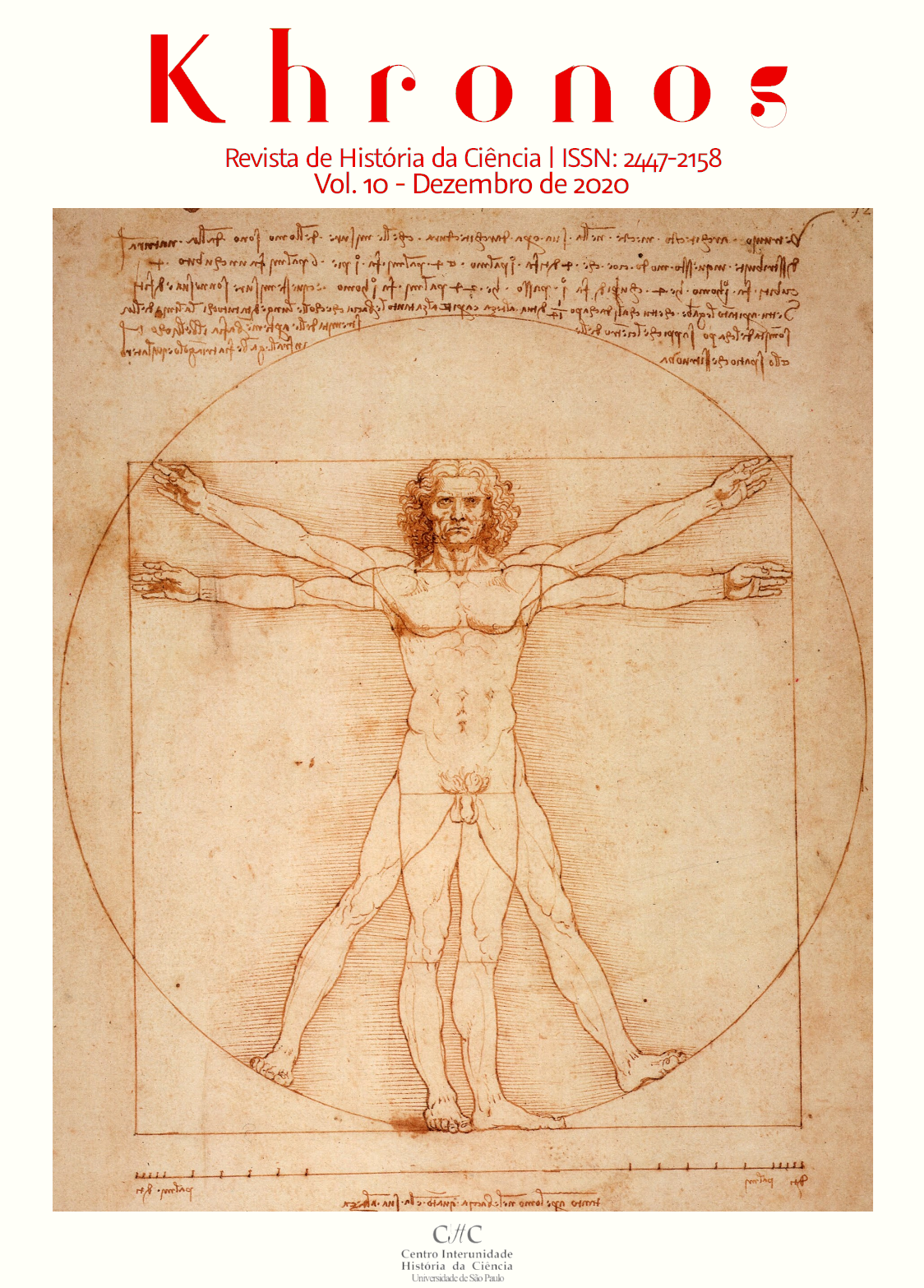Calendars with Olympiad display and eclipse prediction on the Antikythera Mechanism
DOI:
https://doi.org/10.11606/issn.2447-2158.i10p254-322Keywords:
Calendars, Olympiad, Eclipse, Antikythera mechanismAbstract
This article presents the pioneering investigations carried out by member researchers (Freeth et. Al., 2008) of the Anticitera Mechanism Research Project and demonstrate, based on scientific and technological analyzes of the 82 bronze fragments, their inscriptions and gears, the structure and the functions of the first analog computer in history, the Anticitera Mechanism, dated between the centuries150 BC -100 BC, by these authors.
The apparatus, in this context, represents the existence of mechanical design and high technology, certainly involved in this device, capable of predicting astronomical data both from the past, the present and the future.
To better expose their investigations regarding calendars showing the Olympics and forecasting eclipses located at the back of the mechanism, the authors present the data analyzed from the dials; Metonic (upper part) and its subsidiary clocks from the Olympics and the Calyptic cycle, and, the Saros (lower part) with detailed exposure, of the fragments that make up each of the dials, the structure of these calendars, with interpretations and glyph combinations, observations of Babylonian schemes for predictions of lunar and solar eclipses, followed by the identification of problems with the hour glyphs of these predictions.
Given this context, it is worth noting that, some researchers from the São Paulo University's History of Science Center established in Brazil (2017) an Anticitera Mechanism Research Project and has as partners the Catavento Cultural Museum of São Paulo, which it exhibits in Universe space, a replica of the device - donated by the project leaders -, the Renato Archer Information Technology Center (CTI), and the Three-dimensional Technologies Nucleus (NT3D), from Campinas São Paulo, which are joining forces to rebuild a dynamic replica from the apparatus with all its possible functions discovered so far in order to enable access to history as a heritage of all humanity and to enhance technological and museum education in the historical, cultural and scientific scenario.
Downloads
References
American Philosophical Society 81/6 (American Philosophical Society, Philadelphia, 1991).
AABOE, A. Remarks on the theoretical treatment of eclipses in antiquity. J. Hist. Astron. 3, 105–118. 1972.
BICKERMAN, E. Chronology of the Ancient World. Thames & Hudson, London, 1968.
BRITTON, J. P. Calendars, Intercalations and Year-Lengths in Mesopotamian Astronomy. In Calendars and Years: Astronomy and Time in the Ancient Near East (ed. Steele, J.M.) 115-132. Oxbow, Oxford, 2007.
BRITTON, J. P. in Die Rolle der Astronomie in den Kulturen Mesopotamiens (ed. Galter, H. D.) 61–76 (rm-Druck & Vergansgesellschaft, Graz), 1993.
CABANES, P. (ed.) Corpus des inscriptions grecques d'Illyrie méridionale et d'Épire. Études epigraphiques 2.2, 98-99 (Fondation D. et É. Botzaris, Athens, 1997).
CABANES, P. Les concours des Naia de Dodone. Nikephoros - Zeitschrift Fur Sport und Kultur Im Altertum 1, 49–84. 1988.
DILLON, M. Pilgrims and Pilgrimage in Ancient Greece. 99–106. Routledge, London, 1997.
ECONOMOU, N.A. in Antikythera Mechanism. Astronomical Measurement Instruments from Ancient Greek Tradition (eds Economou, N. A., Nikolantonakis, K. & Nitsiou, P.) 14 (Technology Museum of Thessaloniki, Thessaloniki, 2000).
EDMUNDS, M. et al. The Antikythera Mechanism research project. Disponível em: <http://www.antikythera-mechanism.com>, 2008.
ESPENAK, F. NASA eclipse. Disponível em: <http://eclipse.gsfc.nasa.gov/eclipse.htmlæ>, 2008.
EVANS, J. & BERGGREN, J. L. Geminos’s Introduction to the Phenomena. Princeton Univ. Press, Princeton, 2006.
FOTHERINGHAM, J. K. The Metonic and Callippic Cycles. Monthly Notices of the Royal Astronomical Society. 84, 383-392, 1924.
FREETH, T. et al. Decoding the ancient Greek astronomical calculator known as the Antikythera Mechanism. Nature 444, 587–591 (2006).
GINZEL, F. K. Handbuch der mathematischen und technischen Chronologie. Hinrichs, Leipzig, 1906-1914.
HADLAND, R. et al. Antikythera mechanism research project: The inspection. Disponível em: < http://www.xtekxray.com/applications/antikythera.htmlæ>, 2008.
HANNAH, R. Greek & Roman Calendars: Constructions of Time in the Classical World. Duckworth, London, 170 p. 2005.
HULTSCH, F. Pappi Alexandrini collectionis quae supersunt 1026 (Book 8, Vol. 3, Weidmann, Berlin, 1878.
HUNGER, H. Astronomical Diaries and Related Texts from Babylonia. Volume V: Lunar and Planetary Texts (Österreichische Akademie der Wissenschaften, Vienna, 2001).
JONES, A. Calendrica, I: New Callippic dates. Z. Papyrologie Epigraphik 129, 141–158, 2000.
KEYES, C. W. Cicero XVI, De Re Publica, Book 1, Sect. xiv, Para. 22. Loeb Classical Library No. 213, Harvard Univ. Press, Cambridge, Massachusetts, 1928.
MALZBENDER, T. & GELB, D. Polynomial Texture Mapping (PTM). Disponível em: <http:// www.hpl.hp.com/research/ptmæ>. 2006.
MORETTI, L. Iscrizioni Agonistiche Greche, (Angelo Signorelli, Rome, 1953).
NEUGEBAUER, O. A History of Ancient Mathematical Astronomy. Springer, New York, 617 p. 1975.
NEUGEBAUER, O. et al. A Demotic Lunar Eclipse Text of the First Century BC. Proceedings of the American Philosophical Society 125, 312-327 (1981).
PRICE, D. de S. Gears from the Greeks: The Antikythera Mechanism—A calendarcomputer from ca. 80 BC. Trans. Am. Phil. Soc. New Ser., 64, 1–70 (1974); reprintedby Science History Publications, New York, 1975).
SAMUEL, A. E. Greek and Roman Chronology, Calendars and Years in Classical Antiquity (Handbuch der Altertumswissenschaft, Abt. 1., Teil. 7, Beck, München, 1972.
STEELE, J. M. Eclipse prediction in Mesopotamia. Arch. Hist. Exact Sci. 54, 421–454, (2000).
STEELE, J. M. Observations and Predictions of Eclipse Times by Early Astronomers. Kluwer, Dordrecht, 2000.
STEELE, J. M. The Length of the Month in Mesopotamian Calendars of the First Millennium BC. In Calendars and Years: Astronomy and Time in the Ancient Near East (ed. Steele, J. M.), 133-148, Oxbow, Oxford, 2007.
TOOMER, G. J. Ptolemy’s Almagest. Duckworth, London, 1984.
TRÜMPY, C. Untersuchungen zu den altgriechischen Monatsnamen und Monatsfolgen (Bibliothek der Klassischen Altertumswissenschaften, NF, 2nd series, Vol. 98, Carl Winter, Heidelberg, 1997.
WALKER, C. B. F. Achaemenid Chronology and the Babylonian Sources. In Mesopotamia and Iran in the Persian Period (ed. Curtis, J.) 17-25, (British Museum, London, 1997)
WRIGHT, M. T. A. Planetarium Display for the Antikythera Mechanism. Horological Journal. 144,169-173, 2002.
WRIGHT, M. T. Counting months and years: The upper back dial of the Antikythera Mechanism. Bull. Sci. Instrum. Soc. 87, 8–13, 2005.
WRIGHT, M. T. Epicyclic gearing and the Antikythera Mechanism, Part I. Antiquar. Horol. 27, 270–279 (2003).
WRIGHT, M. T. Epicyclic gearing and the Antikythera Mechanism, Part II. Antiquar. Horol. 29, 51–63 (2005).
WRIGHT, M. T. The Antikythera Mechanism and the early history of the moonphase display. Antiquary. Horol. 29, 319–329. 2006.
WRIGHT, M. T. The Antikythera Mechanism: A new gearing scheme. Bull. Sci. Instrum. Soc. 85, 2–7 (2005).
Downloads
Published
Issue
Section
License
Copyright (c) 2020 Beatriz Bandeira

This work is licensed under a Creative Commons Attribution-NonCommercial 4.0 International License.
Authors who publish in this journal agree to the following terms:
- Authors retain the copyright and grant the journal the right to first publication, with the work simultaneously licensed under the Creative Commons Attribution License in the "Attribution-NonCommercial 4.0 International" (CC BY-NC 4.0) modality that allows sharing of the work with acknowledgment of authorship and initial publication in this magazine.
- Authors are authorized to assume additional contracts separately, for non-exclusive distribution of the version of the work published in this journal (eg, publishing in institutional repository or as a book chapter), with acknowledgment of authorship and initial publication in this journal.
- Authors are allowed and encouraged to publish and distribute their work online (eg in institutional repositories or on their personal page) at any point before or during the editorial process, as this can generate productive changes, as well as increase impact and citation of the published work (See The Effect of Open Access).
- Any doubts or complaints about copyright must be directed to the Editorial Board or qualify and express themselves in accordance with the guidelines of the Committee on Publications Ethics (COPE).





